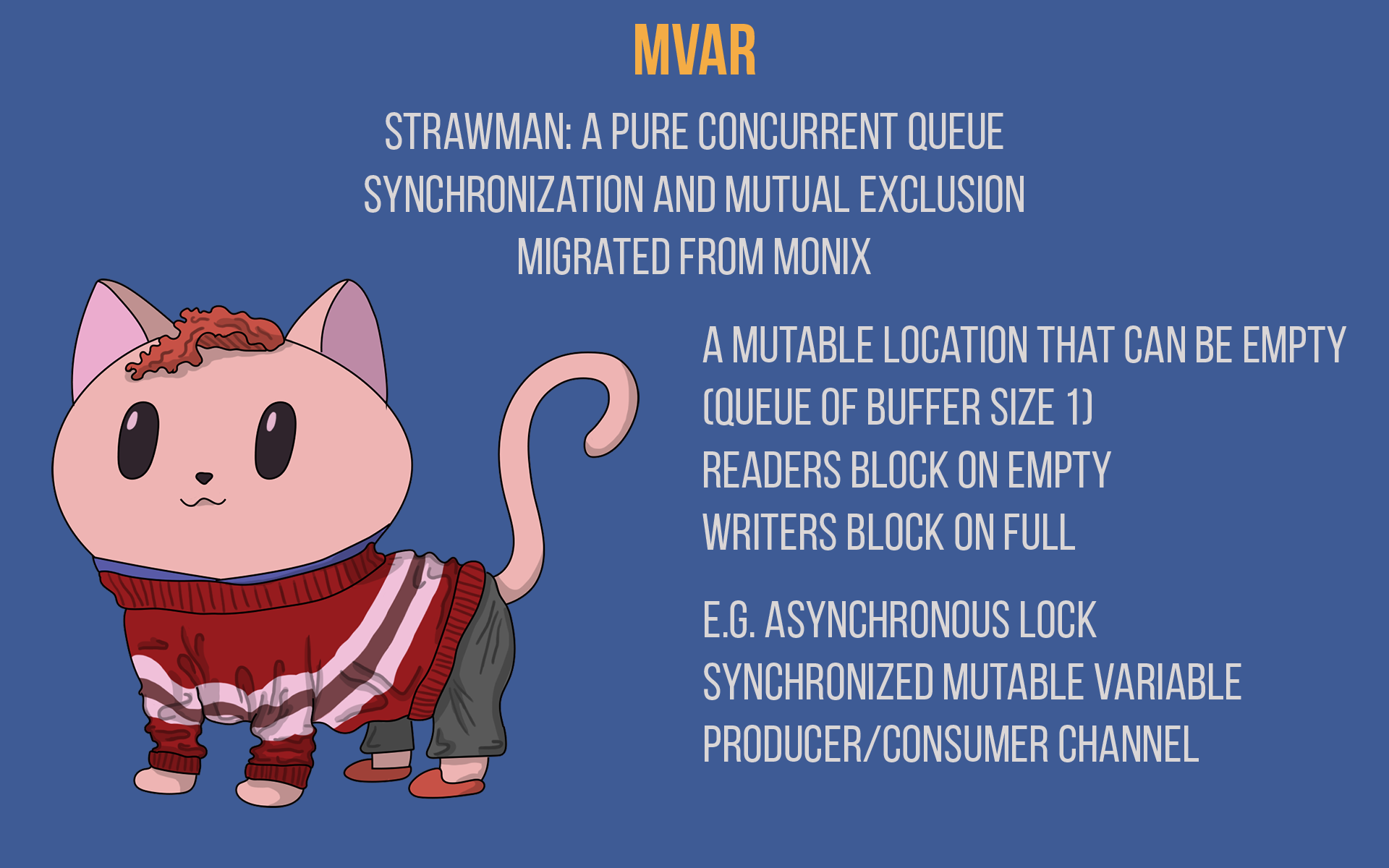MVar

An MVar2 is a mutable location that can be empty or contain a value,
asynchronously blocking reads when empty and blocking writes when full.
abstract class MVar2[F[_], A] {
def put(a: A): F[Unit]
def swap(b: A): F[A]
def take: F[A]
def read: F[A]
def tryPut(a: A): F[Boolean]
def tryTake: F[Option[A]]
def tryRead: F[Option[A]]
}
Update 2.2.0: MVar2 adds new methods to the MVar interface
without breaking binary compatibility. Please upgrade to MVar2
that supports tryRead and swap.
Introduction
Use-cases:
- As synchronized, thread-safe mutable variables
- As channels, with
takeandputacting as "receive" and "send" - As a binary semaphore, with
takeandputacting as "acquire" and "release"
It has these fundamental (atomic) operations:
put: fills theMVarif it is empty, or blocks (asynchronously) if theMVaris full, until the given value is next in line to be consumed ontaketake: tries reading the current value (also emptying it), or blocks (asynchronously) until there is a value available, at which point the operation resorts to atakefollowed by aputread: which reads the current value without modifying theMVar, assuming there is a value available, or otherwise it waits until a value is made available viaputswap: put a new value and return the taken one. It is not atomic.tryRead: returns the value immediately and None if it is empty.tryPutandtryTakevariants of the above, that try those operation once and fail in case (semantic) blocking would be involved
In this context "asynchronous blocking" means that we are not blocking any threads. Instead the implementation uses callbacks to notify clients when the operation has finished (notifications exposed by means of [Async](/cats-effect/docs/2.x/typeclasses/async) or [Concurrent](/cats-effect/docs/2.x/typeclasses/concurrent) data types such as [IO](/cats-effect/docs/2.x/datatypes/io)) and it thus works on top of JavaScript as well.
Inspiration
This data type is inspired by Control.Concurrent.MVar from Haskell, introduced in the paper
Concurrent Haskell,
by Simon Peyton Jones, Andrew Gordon and Sigbjorn Finne, though some details of
their implementation are changed (in particular, a put on a full MVar used
to error, but now merely blocks).
Appropriate for building synchronization primitives and performing simple
interthread communication, it's the equivalent of a BlockingQueue(capacity = 1),
except that there's no actual thread blocking involved and it is powered by data types such as IO.
Use-case: Synchronized Mutable Variables
import cats.effect.concurrent._
def sum(state: MVar2[IO, Int], list: List[Int]): IO[Int] =
list match {
case Nil => state.take
case x :: xs =>
state.take.flatMap { current =>
state.put(current + x).flatMap(_ => sum(state, xs))
}
}
MVar.of[IO, Int](0).flatMap(sum(_, (0 until 100).toList))
This sample isn't very useful, except to show how MVar can be used
as a variable. The take and put operations are atomic.
The take call will (asynchronously) block if there isn't a value
available, whereas the call to put blocks if the MVar already
has a value in it waiting to be consumed.
Obviously after the call for take and before the call for put happens
we could have concurrent logic that can update the same variable.
While the two operations are atomic by themselves, a combination of them
isn't atomic (i.e. atomic operations don't compose), therefore if we want
this sample to be safe, then we need extra synchronization.
Use-case: Asynchronous Lock (Binary Semaphore, Mutex)
The take operation can act as "acquire" and put can act as the "release".
Let's do it:
final class MLock(mvar: MVar2[IO, Unit]) {
def acquire: IO[Unit] =
mvar.take
def release: IO[Unit] =
mvar.put(())
def greenLight[A](fa: IO[A]): IO[A] =
acquire.bracket(_ => fa)(_ => release)
}
object MLock {
def apply(): IO[MLock] =
MVar[IO].of(()).map(ref => new MLock(ref))
}
Use-case: Producer/Consumer Channel
An obvious use-case is to model a simple producer-consumer channel.
Say that you have a producer that needs to push events. But we also need some back-pressure, so we need to wait on the consumer to consume the last event before being able to generate a new event.
import cats.effect._
import cats.effect.concurrent._
// Signaling option, because we need to detect completion
type Channel[A] = MVar2[IO, Option[A]]
def producer(ch: Channel[Int], list: List[Int]): IO[Unit] =
list match {
case Nil =>
ch.put(None) // we are done!
case head :: tail =>
// next please
ch.put(Some(head)).flatMap(_ => producer(ch, tail))
}
def consumer(ch: Channel[Int], sum: Long): IO[Long] =
ch.take.flatMap {
case Some(x) =>
// next please
consumer(ch, sum + x)
case None =>
IO.pure(sum) // we are done!
}
// ContextShift required for
// 1) MVar.empty
// 2) IO.start
// for ContextShift documentation see https://typelevel.org/cats-effect/datatypes/contextshift.html
import scala.concurrent.ExecutionContext
implicit val cs = IO.contextShift(ExecutionContext.Implicits.global)
for {
channel <- MVar[IO].empty[Option[Int]]
count = 100000
producerTask = producer(channel, (0 until count).toList)
consumerTask = consumer(channel, 0L)
fp <- producerTask.start
fc <- consumerTask.start
_ <- fp.join
sum <- fc.join
} yield sum
Running this will work as expected. Our producer pushes values
into our MVar and our consumer will consume all of those values.
